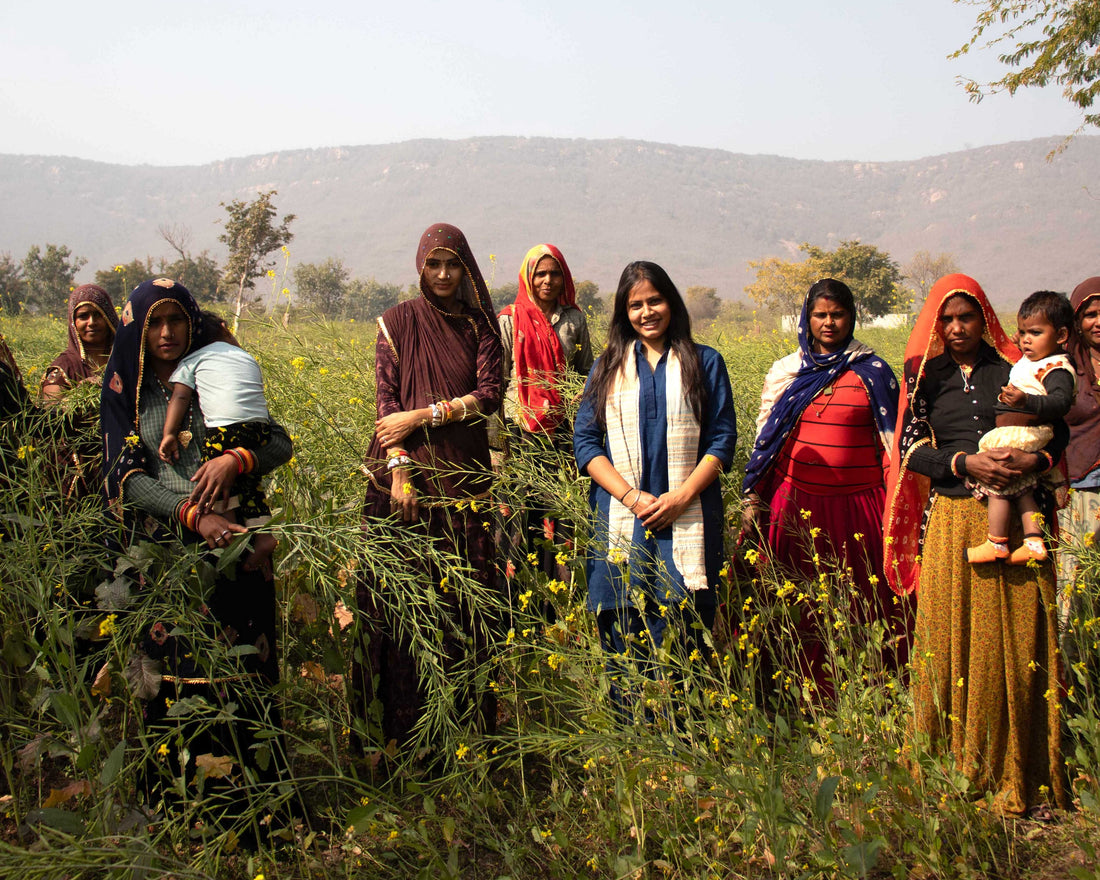
Five Minutes With a Friend: Juhi Sharma of Vamika
Join us tomorrow, Saturday 6 July, to Meet Juhi Sharma of Vamika who will share her journey to preserve the craft skills of the Kalbeliya community.
Nestled in the heartland of Rajasthan, amidst the vibrant tapestry of culture and tradition, Vamika emerges with a commitment to empowerment and sustainability by revitalising neglected craft skills among the Kalbeliya community.

With meticulous craftsmanship, Vamika weaves exceptional pieces that narrate the rich heritage of Rajasthan's nomadic tribes. Each stitch, each appliqué, carries a unique tale, blending tradition with modernity and honouring the diversity of cultural narratives.
As the founder and creative director, Juhi Sharma envisions a future where tradition and empowerment intersect harmoniously. With every stitch, Vamika stitches together a story of resilience, empowerment, and hope, leaving an indelible mark on Rajasthan's cultural landscape.
This week we interviewed Juhi to find out more about her textile story in preparation for Saturday's event.

What is your first memory of a textile?
My first memory of a textile is from my college graduation project. My project was focused on Kota Doria, a traditional craft from Kota, Rajasthan, where I am from. As I studied the various textiles of Rajasthan, I realised that this is the field I want to pursue further to create a positive impact on society.
Can you put into words what you love about textiles?
I love textiles' ability to tell a story and connect us to our cultural heritage. Each piece is a blend of history, craftsmanship, and artistry, reflecting the traditions and skills passed down through generations. Working with textiles allows me to preserve and promote these cultural narratives while also exploring innovative designs and techniques. This blend of tradition and innovation is what excites me the most about textiles and motivates me to contribute to this vibrant field.
If you make textiles, where is your most inspiring space/place to create?
If I make textiles, my most inspiring space to create is my hometown, Kota, Rajasthan. The vibrant environment, rich history, and study of the culture of a nomadic tribe, along with the traditional craftsmanship of the Kalbeliya community and other marginalised communities, provide endless inspiration. Being surrounded by skilled artisans and the cultural essence of my hometown fuels my creativity and passion for textile design. This connection to my roots not only inspires my work but also makes me feel a deep sense of purpose and that I truly belong in the world of textiles.
What has inspired you recently?
Since my graduation project, I have had the privilege to collaborate with nomadic tribes through NGOs like Bhasha Research and Publication Centre and Kota Heritage Society, and it is from these skilled artisans that I draw my inspiration. These artisans, who have honed their craft outside formal educational institutions, continually impress me with their innovative approach to textile art. Their ability to blend traditional techniques with contemporary forms is incredibly captivating. Their dedication to pushing the boundaries of textile art while preserving craft traditions resonates deeply with my aspirations in this field. Exploring their creations has ignited fresh ideas and perspectives in my journey, inspiring me to explore new techniques and approaches.

What is your most cherished textile, and why?
I'm from Rajasthan, where all types of textiles are important to me. Each textile tells a story about tradition, sustainability, culture, and the different communities here. For example, the detailed embroidery of the Kalbeliya community shows their rich history and way of life, which I feel a strong connection to. This textile is special to me because it represents the amazing skills of local artisans and the cultural heritage of my community. It's intricately designed with delicate patterns that have been passed down through many generations.
Where did you learn your craft?
During my graduation project on Kota Doria, I explored various crafts of Rajasthan. It was during this time, amidst the COVID-19 pandemic, that I realised artisans have deep design knowledge—they are the true designers who can bridge old cultures with the modern world, given the chance. However, their livelihoods often don't reflect their skills. This motivated me to work with them. With support from NGOs like Bhasha Research and Publication Centre and Kota Heritage Society, I furthered my learning and understanding of this craft, and have continued to advance its legacy since then.
Images courtesy of Vamika and the Kalbeliya community
Meet Juhi Sharma of Vamika (Kalbeliya Embroidery) tomorrow, Saturday 6 July, for just £5.
Find out more and book your ticket:
www.selvedge.org/products/meet-juhi-sharma-of-vamika
Nestled in the heartland of Rajasthan, amidst the vibrant tapestry of culture and tradition, Vamika emerges with a commitment to empowerment and sustainability by revitalising neglected craft skills among the Kalbeliya community.

With meticulous craftsmanship, Vamika weaves exceptional pieces that narrate the rich heritage of Rajasthan's nomadic tribes. Each stitch, each appliqué, carries a unique tale, blending tradition with modernity and honouring the diversity of cultural narratives.
As the founder and creative director, Juhi Sharma envisions a future where tradition and empowerment intersect harmoniously. With every stitch, Vamika stitches together a story of resilience, empowerment, and hope, leaving an indelible mark on Rajasthan's cultural landscape.
This week we interviewed Juhi to find out more about her textile story in preparation for Saturday's event.

What is your first memory of a textile?
My first memory of a textile is from my college graduation project. My project was focused on Kota Doria, a traditional craft from Kota, Rajasthan, where I am from. As I studied the various textiles of Rajasthan, I realised that this is the field I want to pursue further to create a positive impact on society.
Can you put into words what you love about textiles?
I love textiles' ability to tell a story and connect us to our cultural heritage. Each piece is a blend of history, craftsmanship, and artistry, reflecting the traditions and skills passed down through generations. Working with textiles allows me to preserve and promote these cultural narratives while also exploring innovative designs and techniques. This blend of tradition and innovation is what excites me the most about textiles and motivates me to contribute to this vibrant field.
If you make textiles, where is your most inspiring space/place to create?
If I make textiles, my most inspiring space to create is my hometown, Kota, Rajasthan. The vibrant environment, rich history, and study of the culture of a nomadic tribe, along with the traditional craftsmanship of the Kalbeliya community and other marginalised communities, provide endless inspiration. Being surrounded by skilled artisans and the cultural essence of my hometown fuels my creativity and passion for textile design. This connection to my roots not only inspires my work but also makes me feel a deep sense of purpose and that I truly belong in the world of textiles.
What has inspired you recently?
Since my graduation project, I have had the privilege to collaborate with nomadic tribes through NGOs like Bhasha Research and Publication Centre and Kota Heritage Society, and it is from these skilled artisans that I draw my inspiration. These artisans, who have honed their craft outside formal educational institutions, continually impress me with their innovative approach to textile art. Their ability to blend traditional techniques with contemporary forms is incredibly captivating. Their dedication to pushing the boundaries of textile art while preserving craft traditions resonates deeply with my aspirations in this field. Exploring their creations has ignited fresh ideas and perspectives in my journey, inspiring me to explore new techniques and approaches.

What is your most cherished textile, and why?
I'm from Rajasthan, where all types of textiles are important to me. Each textile tells a story about tradition, sustainability, culture, and the different communities here. For example, the detailed embroidery of the Kalbeliya community shows their rich history and way of life, which I feel a strong connection to. This textile is special to me because it represents the amazing skills of local artisans and the cultural heritage of my community. It's intricately designed with delicate patterns that have been passed down through many generations.
Where did you learn your craft?
During my graduation project on Kota Doria, I explored various crafts of Rajasthan. It was during this time, amidst the COVID-19 pandemic, that I realised artisans have deep design knowledge—they are the true designers who can bridge old cultures with the modern world, given the chance. However, their livelihoods often don't reflect their skills. This motivated me to work with them. With support from NGOs like Bhasha Research and Publication Centre and Kota Heritage Society, I furthered my learning and understanding of this craft, and have continued to advance its legacy since then.
Images courtesy of Vamika and the Kalbeliya community
Meet Juhi Sharma of Vamika (Kalbeliya Embroidery) tomorrow, Saturday 6 July, for just £5.
Find out more and book your ticket:
www.selvedge.org/products/meet-juhi-sharma-of-vamika
